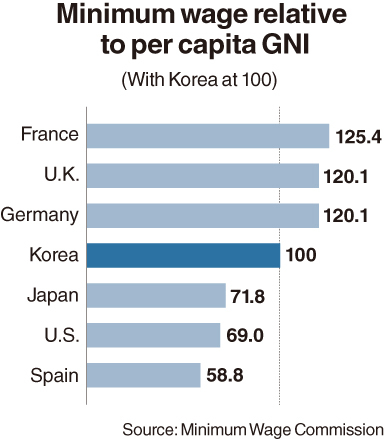[THE INVESTOR] Labor and management representatives continued to run parallel last week at the fourth and latest round of negotiations on setting the minimum wage across the country next year.
Labor groups insist that the 2017 minimum wage should be pegged at 10,000 won ($8.59) per hour, up 65.8 percent from 6,030 won this year, while business circles call for a freeze.
According to data from the Minimum Wage Commission, Korea’s minimum wage rose by an annual average of 8.7 percent over the 15 years from 2000, reaching 5,580 won in 2015. The pace of increase was steeper than the rates of growth in consumer prices and labor productivity, which averaged 2.7 percent and 4.7 percent, respectively, over the cited period.

Labor representatives argue that the country’s minimum wage still remains below that of other advanced countries, noting that Korea ranks 17th among 25 members of the Organization for Economic Cooperation and Development that have adopted the minimum wage system.
They also claim raising the minimum wage in keeping with the global trend would help reduce widening income inequality and boost domestic spending.
The labor group’s stance has been backed by opposition parties, which pledged to raise the hourly minimum wage to 10,000 won during April’s general election campaign.
But employers argue that demands for a steep hike in minimum wage are based on inaccurate and misconstrued assumptions.
They note that the OECD ranking can hardly be a base for objective comparison, as the minimum wage in Korea comprises basic pay and fixed allowance while that in many European countries includes bonus and various allowances.
In terms of the minimum wage level relative to per capita gross national income, Korea ranks seventh among OECD members, according to figures from the Minimum Wage Commission. With Korea at 100, the comparative figures stand at 125.4 in France, 120.1 in Britain, 102.1 in Germany, 71.8 in Japan, 69.0 in the U.S. and 58.8 in Spain.
Business circles note that recent moves by the U.S. and Japan toward raising their minimum wage come after a long period of freeze or paltry gain.
The country saw the proportion of labor income to gross national income reach the lowest level of 59.4 percent in 2010 before rising back in the following years to a record high of 62.9 percent last year.
Lee Jung-min, a professor of economics at Seoul National University, noted that, contrary to its purported purpose of supporting low-income laborers, the minimum wage raise mainly helped increase the income of middle-class workers, who account for 44 percent of employees entitled to minimum wage in the country.
Employers argue the minimum wage increase might result in fewer job opportunities for low-income, low-skilled workers.
With politicians poised to stand by labor groups, it seems hard for the minimum wage to be set at a level that management considers suitable.
Another contentious issue at the negotiations, which are also joined by government-appointed delegates, is whether to differentiate minimum wage by industrial sectors and regions.
Many experts note that more serious consideration needs to be given to the idea as a large number of workers are expected to lose jobs in the process of corporate restructuring this year.
In a move that defied objections from the labor, the municipal government in Geoje, whose economy is heavily dependent on shipyards that are now reeling from dwindling orders, sent a letter to the Minimum Wage Commission to ask for the application of differentiated minimum wage.
“The current system of applying the same minimum wage to all workplaces fails to reflect differences in specific conditions between business sectors and between regional areas,” said Lim Young-tae, an official at the Korea Employers Federation.
According to data from the Bank of Korea, labor productivity increased by 7.9 percent in transportation but decreased by 0.4 percent in construction in 2014. The gap of average wages between different regions widened to as much as 30 percent.
Different levels of prices and housing cost in large cities and provincial villages also make it reasonable to apply differentiated minimum wages, experts say.
Among the countries that have adopted the system are the U.S., Japan, Australia, Belgium and the Netherlands, according to the KEF.
What also needs to be considered is the differentiation of minimum wage by age, though this would require related laws to be revised.
Job opportunities for the elderly would be reduced more sharply if the minimum wage continues to rise, experts note.
By Kim Kyung-ho (
khkim@heraldcorp.com)




![[Herald Interview] 'Trump will use tariffs as first line of defense for American manufacturing'](http://res.heraldm.com/phpwas/restmb_idxmake.php?idx=644&simg=/content/image/2024/11/26/20241126050017_0.jpg)

![[Health and care] Getting cancer young: Why cancer isn’t just an older person’s battle](http://res.heraldm.com/phpwas/restmb_idxmake.php?idx=644&simg=/content/image/2024/11/26/20241126050043_0.jpg)

